Showfoto/Brightness/uk: Difference between revisions
Created page with 'Під час зйомки було добре видно весь діапазон яскраво-зелених кольорів, а також червонувате лист...' |
Created page with 'Ви можете сказати: «Ага... Ми вже з цим знайомилися! Таку ваду можна виправити за допомогою інструм...' |
||
| Line 25: | Line 25: | ||
Це зображення блякле, занадто світле, йому не вистачає контрастності. Чому? Тому що його кольори не розташовано вздовж всієї гістограми. | Це зображення блякле, занадто світле, йому не вистачає контрастності. Чому? Тому що його кольори не розташовано вздовж всієї гістограми. | ||
Ви можете сказати: «Ага... Ми вже з цим знайомилися! Таку ваду можна виправити за допомогою інструменту <menuchoice>Рівні</menuchoice>! Ми вже обговорювали це у першому розділі посібника!". Так, саме це ми і спробуємо першим. Відкриємо зображення у '''Showfoto''' і скоригуємо рівні: | |||
{|class="tablecenter" style="border:1px solid darkgray;" | {|class="tablecenter" style="border:1px solid darkgray;" | ||
Revision as of 19:43, 18 September 2010
Посібник з обробки фотографій у KDE 1-4: Яскравість/Контрастність/Гама + Відтінок/Насиченість/Освітленість
Unai Garro (uga) — літо 2008 року
Цю серію посібників було розпочато доволі давно. Всі посібники стосуються виправлення проблем, пов’язаних з освітленням. Ми вже використовували інструменти виправлення рівнів, кривих та балансу білого.
Варто вже звернутися до способів виправлення вад іншого типу, але я вважаю, що опис виправлень, пов’язаних з освітленням, був би неповним без опису виправлення контрастності, яскравості та кольорів. Ймовірно, ви вже маєте певний досвід з цього виправлення, але подібні виправлення варті уваги.
Отже, почнемо. Давайте виправимо ці кольори! ![]()
Вступ:
Багато разів ми знімали чудові ландшафти і вже мріяли про чудові результати, які ми отримаємо щойно повернемося додому. У сучасних цифрових фотоапаратах передбачено можливість попереднього перегляду результатів на рідкокристалічному дисплеї, але, зазвичай, такі перегляди доволі далекі від вартих довіри, отже справжні результати можна переглянути лише вдома.
Отже ми відкриваємо нашу чудову фотографію вдома і, на превелике розчарування, бачимо на ній зовсім не ті кольори, на які сподівалися. Що робити? Звичайно ж, ми знову скористаємося для виправлення Showfoto або Krita!
Нашим зразком буде наведена нижче фотографія:
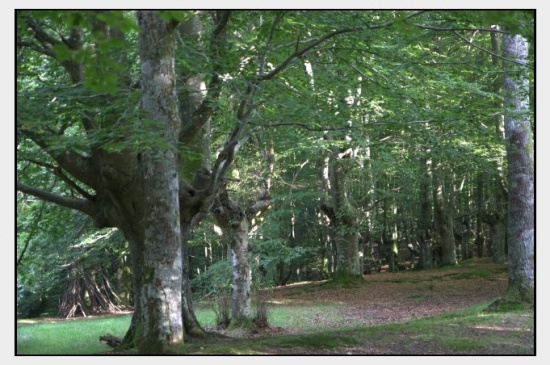
|
Під час зйомки було добре видно весь діапазон яскраво-зелених кольорів, а також червонувате листя на землі. Але якимось чином фотоапарат не зафіксував всіх цих контрастних кольорів. Що таке контраст? Це всього лише відмінність кольорів у межах одного зображення, відмінність певної точки чи ділянки від решти зображення. Чим контрастнішим є зображення, тим чіткіше воно виглядає для нашого ока.
Це зображення блякле, занадто світле, йому не вистачає контрастності. Чому? Тому що його кольори не розташовано вздовж всієї гістограми.
Ви можете сказати: «Ага... Ми вже з цим знайомилися! Таку ваду можна виправити за допомогою інструменту ! Ми вже обговорювали це у першому розділі посібника!". Так, саме це ми і спробуємо першим. Відкриємо зображення у Showfoto і скоригуємо рівні:
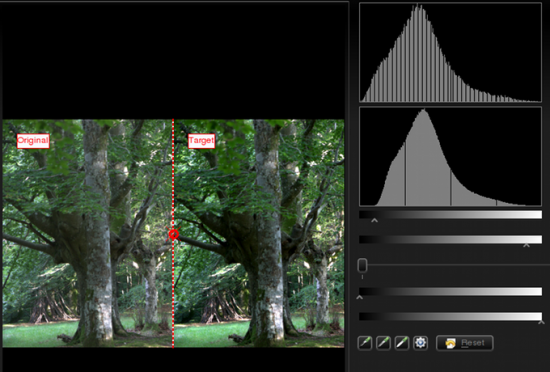
|
В результаті отримаємо таке зображення:
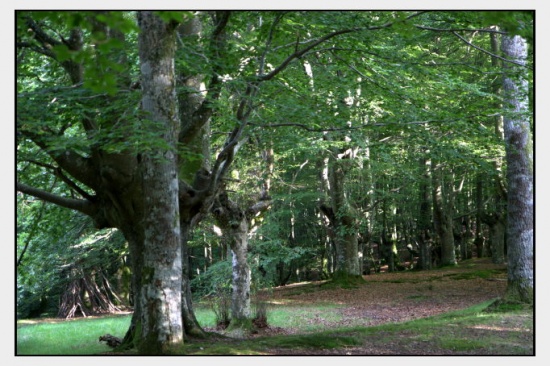
|
Not bad, is it? But still, I had a different photo in my mind. Leaves were greener, there was more contrast (like darker shadows), and the leaves on the floor were more reddish. So can we fix this? Yes, we could use the to improve shadows for example. But I will show you some new tools that can achieve similar results in this case:
У Showfoto скористайтеся пунктом меню :
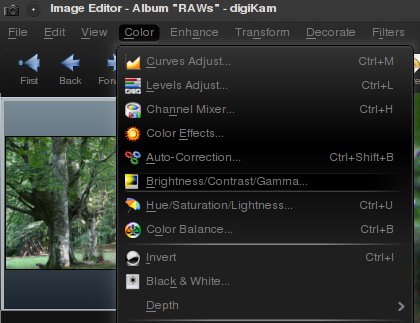
|
Буде відкрито дуже просту панель керування з такими засобами керування:
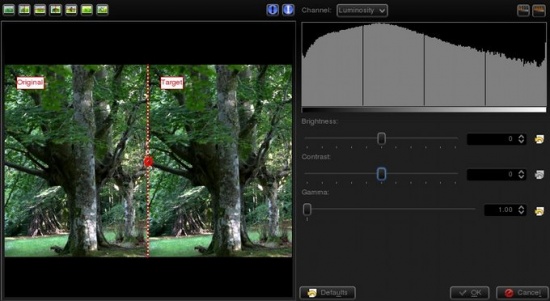
|
The first slider controls the brightness/darkness of the image. The second slider increases or reduces , and uhm... what's ? Look at the following image:
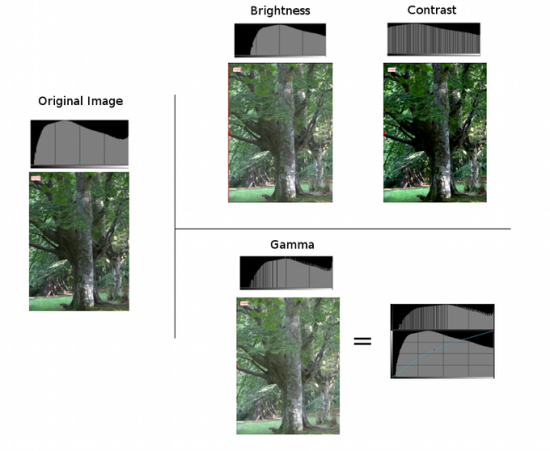
|
The photo and histogram on the left are those of the original image. In the right hand, the three photos show the result of increasing brightness, contrast, and gamma respectively. As you can see, when using the brightness control, it moves the whole histogram to the right. Shadows will dissappear and become light grays. The result isn't very pleasing, as it is less contrasty. This could be fixed by adjusting contrast. In the output, you can see that the histogram has been expanded. This means that each color has been separated further from each other, and thus increase color difference (contrast). The output is much more pleasing than the original image in this case. The image is no more flat, it's much more contrasty, and shadows are clear dark contrasted.
At this point you should have noticed something important. Both contrast and brightness controls can clip the histogram and cause information loss!' Now look at the gamma adjustment. I pushed even further than the first tool, and still, the image wasn't clipped. What did the gamma tool do?
The control is like adjusting the curves tool upwards in the middle (see the figure). It affects mostly to the middle gray levels. Blacks will remain black and whites will remain white. (unlike control where blacks become gray). It compresses the histogram in the right part by compressing highlights, but shadows are expanded and thus causes to extend contrast there.
Given that this tool can clip the histogram, to avoid it as much as I can, I will change the order. Instead of doing then , I will do then . It's usually best adjusting levels after all other light adjustments have been done. So I did the following adjustment to the image:
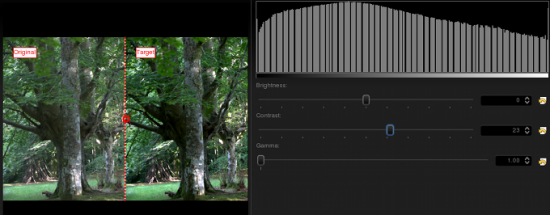
|
I could have pushed contrast even further, but I prefer natural looking photos. Then, afterwards, even if it wasn't much needed due to the clipping, I adjusted levels a bit. This is what I got:
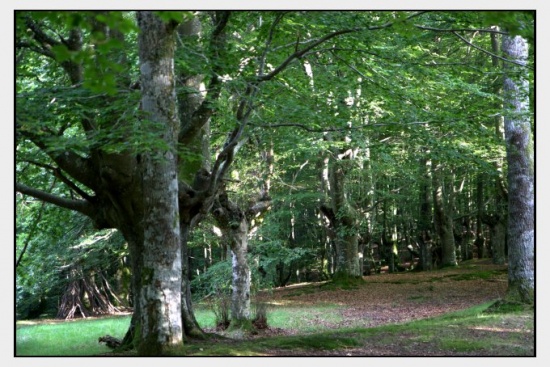
|
The result is similar to the previous one, but a bit more contrasty. Still, I'm missing colors here, something is missing? Of course, lets open the option from the menu:
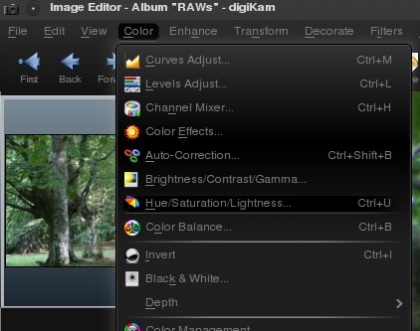
|
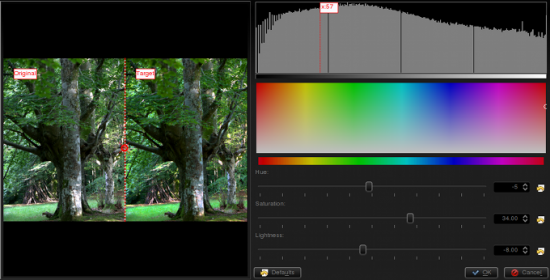
|
It will open a dialog where Showfoto permits adjusting the colors of the image. The control can make colors stronger or weaker. The control permits altering colors towards another one (brighter colors to darker green, or even to yellow...), and finally, can make colors brighter or darker. When the image is lightened up, it causes moving the histogram's dark part upwards and compressing the whole of it on the right, thus blacks dissappear and contrast can be reduced easily thanks to the compression.
In my adjustment, I pushed saturation up to 34, reduced lightness a bit, and retouched the greens by altering the hue slightly. This is what I got finally:
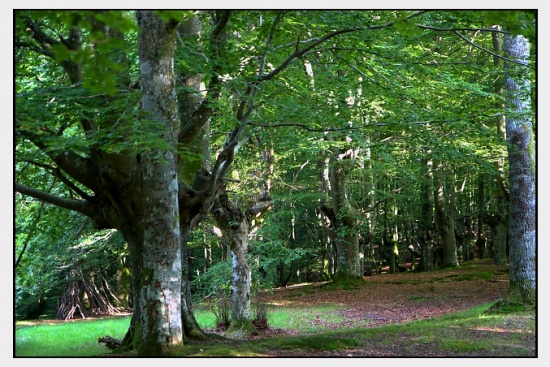
|
Ну, от і все. Маємо прийнятний результат. Це саме те, що бачили мої очі!!!
Дякую за те, що прочитали цей посібник. Сподіваюся, отримані знання вам ще знадобляться. Побачимося у наступному посібнику!
Notes:

